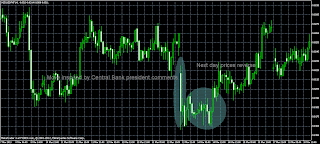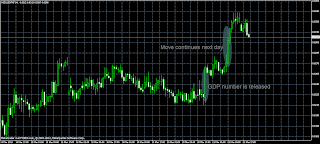I hope you have seen a lot of times some currency pair, stock or commodity rally (or go down) one day and then reverse the next day and end up at the very place where it started the rally (or move down). This kind of price action is very common in financial markets and they have a clear reason behind this as well as a way to trade this and make nice profits. Today I want to talk about the way you can trade this short lived momentum when prices reverse after a move that is usually driven by some fundamental news.
A much better than expected news might trigger an immediate rally upwards, but if that piece of news does not really add to the longer term change for the positive in a currency, stock or a commodity that rally will be short lived and a reversal will ensue the same day or the next one and the security will come back the exact distance it went on the heat of the news to the very place (price level) where the rally started. Only those pieces of news that have longer term impact cause price leave there current ranges and go to new levels without looking back for a considerable period of time. The price may come back to the level of breakout, but if the reason for price move has very strong reason behind it, the price will continue its� course sooner rather than later.
Short lived collapse in New Zealand dollar
However, there are a lot of short lived momentum moves each month and even week that you can capitalize on. Let us look at a few examples now. The first example is with New Zealand dollar. On the 13thof March (2013) there was an important event for the kiwi. It was interest rate decision. That is a very tradable event and prices can move severely when the news comes out. That is exactly what happened this time. If you look at the chart below you will see the gap on the chart (down) as the kiwi collapsed after the news hit the wires. However, you can also see that the reaction to the news was really short lived and nzd/usd pair reversed the next day and continued going up on the third one when it reached the point when the pair started collapsing. Everything that was lost when the news came was gained back as the market digested the impact it may have for the future.
We do know that the chief of the Central Bank of New Zealand made some dovish comments regarding the rate of the kiwi and his willingness to see it significantly lower. We know that this kind of action can purely be attributed to the so called �currency wars� which is a prevalent theme in the markets nowadays. However, as most of Central Banks are trying to do the same the market starts ignoring this game and pays more and more attention to the real economic numbers rather than �currency wars� type of talks.
So, when you see a currency pair or commodity or a stock go down (or up) watch what happens the next day. Be ready to see a reversal if the reason behind the move was not a strong driver.
Data that has longer term impact causes prices to continue in the same direction next day
A completely different picture can be seen when New Zealand GDP numbers were released. Much better than expected number created a move that was not followed by a reversal next day, but did continue. This news has much bigger impact on the markets than some fundamental data which is very changeable (like retail sales) and may not have long term impact on the economy. So, if a reversal does not take place after the strong move you may expect and also trade a continuation of the move.
Short lived Euro collapse after news from Cyprus
Another case of a short lived momentum move is based on the most recent trouble in EU � the Cyprus case. If you remember the action that Cyprus took when it decided to tax all accounts in order to secure a ten billion Euro loan from Europe. The market was shocked by the news and Euro open with a gap down after the weekend on Monday (17th of March 2013).
Let us look at eur/jpy price action for the event. Market gaps down around 300 pips on the open. However, Monday came and market went back where it came from wiping out all the Euro losses on the news. Why? Because market expects the problem will be solved in the nearest future. Yes, I do believe the problems in Euro zone will become uncontrollable at some point and some countries will face bankruptcies, but market does not look that far and it is ready to take risks as bigger profits are where bigger risks are. So, do not be surprised by seeing such illogical price actions in the market when one day you have a huge collapse and then a reversal that pushes the price to exactly the same level where it came from. These kinds of news have short lived momentum. You need a bigger catalyst for prices to continue dropping beyond initial news announcement.
It is much more important whether the Central bank of Europe increases its� stimulus like the FED does or not. Of course, if this kind of action (as Cyprus did) was done by Spain or Greece market would have reacted more wildly and that could have led to more prolonged collapse in Euro, but as long as no country in EU announces its� bankruptcy these kind of events will have short term impact and you can always trade reversals next day.
P.S. I do think that Euro has run its� course and will collapse soon, especially against Japanese Yen. So, watch Yen pairs, because a trend can change any time now as those fail to take previous peaks for some time.
So, I hope you understand now why we see such illogical choppy price actions regularly in financial markets and you do know how to trade them.
Ok. I hope you benefited from the post. If you liked the post I would also be happy if you gave a plus on Google+, tweeted, liked it on Facebook and other social platforms. Have a nice day.
Vytas.
See also my previous post: How to make money in trading breakouts
Disclaimer
Trading financial markets carries a high level of risk, and may not be suitable for all investors. All information on the blog http://trend0.blogspot.com/ is of educational nature and cannot be considered as advice, recommendation or signals to trade in any financial markets.



No comments:
Post a Comment